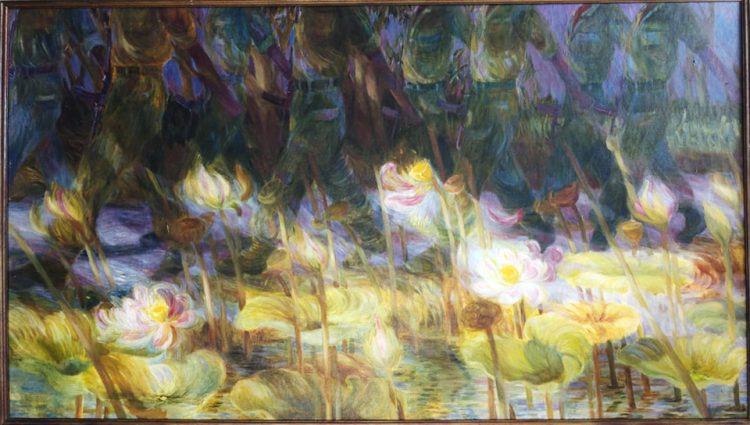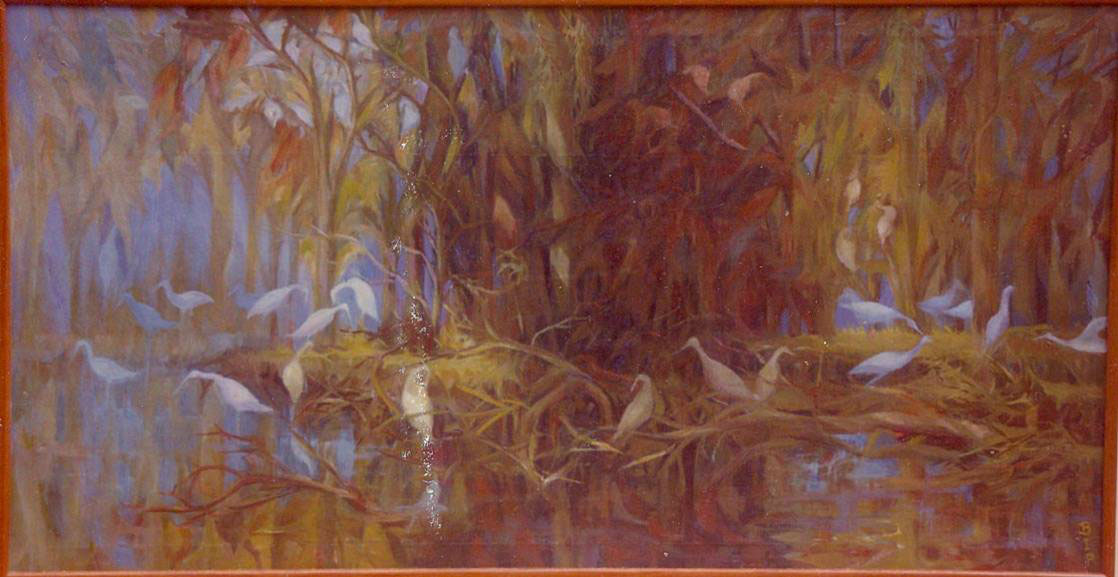

(Photo: Courtesy of the artist)
In a revised and reprinted version of her text first published in the Catholic Standard in late 1980, Persaud writes about Dudley Charles’ recent exhibition: “Charles’ new forms, with their full–blooded vigour and intrinsic honesty, starkly contrast with those which have in the past graced the Umana: studied, clever concoctions of form and colour, by his contemporaries […] pale into insignificance next to his images of pain, pathos, cruelty, horror and oppression. It is a momentous happening in the field of Guyanese art! The artist has finally managed to transcend the ongoing intellectual agony over identity and roots. He has dared to respond as a human: has refused to be numb and detached; and this constitutes a landmark when one considers our arid aesthetic traditions over the last decade.” Writing about Charles was as if Persaud forecasted her own maturation as an artist. In just a few years, similar statements could be made about her paintings … but, I jump ahead of myself.
Despite an acute awareness of 1980 Guyana, the politically astute Persaud was not immediately overt in her visual critiques of place. Persaud’s early paintings instead were fragments of nature – buttercups and lotus lilies, with paintings bearing titles like Sunday at the Botanic, Bird Island 1, Bird Island 2, and Taking Wing. Furthermore, Persaud’s paintings explored the ebbs and flows of life filtered through the vegetation of the Garden; they were a means of personal mediation with familial loss. These explorations and mediations resulted in the aptly titled first solo exhibition Fragments of Life hosted at the JFK Library, Georgetown in 1984. It was at this exhibition that Counterpoint (shared with last week’s article) was first shown. Counterpoint provoked strong responses from viewers. And their tendency to overlook commentary on their daily national reality in favour of recent events elsewhere in the Caribbean, motivated Persaud to extend the painting’s content in a series of images. Thus, Persaud’s iconic A Gentleman in the Gardens series was birthed.
Persaud’s status among Guyanese artists, however, was quickly cemented when in 1985 she became the first woman to win the National Visual Art Competition. Then, competitors from all disciplines of visual art competed for the first prize, and the competition under different names had been a regular feature for decades. Within this context, Persaud’s win was even more significant. Additionally, her winning painting Bird Island 3 – End of a Season, now in the Guyana National Collection, had been among the paintings at the aforementioned exhibition the year prior. The composition’s communal white birds and mangle of vegetation obscure a dark and ominous core right of the painting’s vertical axis. The tranquil waters which reflect both the birds and vegetation belie any threat that may lurk within the water’s depths.
In 1986, 12 of Persaud’s paintings accompanied by text from Martin Carter’s poetry appeared on the walls of the Centre for Brazilian Studies in Georgetown. This was the year of the A Gentleman in the Gardens exhibition. Of the 12, two paintings were precursors of the Gentleman series including the painting from which the series and exhibition took its name. Counterpoint, the ideological start of the series was also included and so were three paintings in the nascent series. Now, unlike Charles, Persaud subsumed echoes of individual and collective pain and pathos, and politicised cruelty and horror in ironic juxtapositions of beauty and (in)security. Persaud unabashedly asserted herself as an artist whose work would be an agent of critical thought and a partner of a political consciousness.
Five years later, as historical fact was not being hotly contested and rational and sensible times prevailed, el Instituto Venezolano para la Cultura y la Cooperación (IVCC) hosted Persaud’s, third solo exhibition – Bernadette Persaud 1983-1991. This third solo exhibition came on the heels of a group show hosted by the IVCC in 1986 – Life and Myths of Guyana – with work by Persaud, Philip Moore, Stanley Greaves, and Dudley Charles.
As Charles noted, the Venezuelan diplomats in Guyana were very supportive of Guyanese artists; “so long as they saw you were doing good work, they were happy to show your work.” They would purchase Guyanese art as well. Thus, Charles surmised that there is quite a large collection of Guyanese art in Venezuela that stems from these encounters as well as the Government of Guyana’s gifting diplomats with art. Similarly, Persaud recalls friendliness and cordiality from Venezuelan diplomats towards Guyanese artists. Thus, exhibiting at the IVCC was a gesture of neighbours embracing each other through cultural exchange.
From 1991 to 1999, Persaud was the painting tutor for upper-level students at the E R Burrowes School of Art (BSA). There in the outdoor space beyond the walls of the ground floor enclosure and under the overhang of the first floor, BSA’s longtime artist-in-residence Philip Moore painted calabashes, barrels, canvases … In other words, he created, as he conversed with those who came to sit or work in the midst of the tiny sculpture studio which he shared with the school’s sculpture tutor and her students. Persaud was among the regulars to sit with Moore. Not surprising, as the two had a long-standing friendship grounded in probing intellectual discourse. Moore, Persaud noted, furtively pushed the notion that an authentic art was only possible for Guyanese artists through a relationship with one’s roots. While many responded superficially, Persaud noted that Moore was in fact “preaching” for a return to one’s “spiritual roots.” Thus, a byproduct of Persaud’s conversations and interactions with Moore was her return to the religious-spiritual culture of her ancestors. As a consequence, substantial readings of both Islamic and Hindu texts became a font of inspiration when the spectre that informed the Gentleman series no longer characterised the reality of resident Guyanese.
As she forecasted the blunt political images of the Gentleman series in her review of Charles’ work, Persaud’s eventual Indian – primarily Hindu – shift was also forecasted by her. In both Counterpoint and Gentleman in the Gardens, the lotus flower is as significant a presence as the man with the gun in the former and the marching men (in their government boots) in the latter. In fact, in the latter painting, the lotus flowers in their different stages of bloom dominate the foreground of the picture plane and suggest the end of yet another season.
(To be continued)
Akima McPherson is an artist, art historian, and educator.






